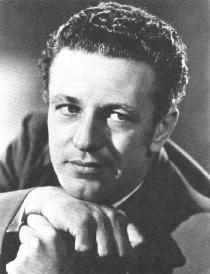
Back Nicholas Ray AN نيكولاس راي Arabic نيكولاس راى ARZ Никълъс Рей Bulgarian নিকোলাস রে Bengali/Bangla Nicholas Ray Catalan نیکۆڵاس ڕەی CKB Nicholas Ray Czech Nicholas Ray Danish Nicholas Ray German
This article may contain an excessive amount of intricate detail that may interest only a particular audience. (October 2024) |
Nicholas Ray | |
|---|---|
 Ray c. 1950 | |
| Born | Raymond Nicholas Kienzle Jr. August 7, 1911 Galesville, Wisconsin, U.S. |
| Died | June 16, 1979 (aged 67) New York City, U.S. |
| Occupations |
|
| Years active | 1946–1979 |
| Spouses | Jean (Abrams) Evans
(m. 1936; div. 1942)Betty Utey
(m. 1958; div. 1970)Susan Schwartz (m. 1971) |
| Children | 4, including Anthony Ray |
Nicholas Ray (born Raymond Nicholas Kienzle Jr., August 7, 1911 – June 16, 1979) was an American film director, screenwriter, and actor. Described by the Harvard Film Archive as "Hollywood's last romantic"[1] and "one of postwar American cinema’s supremely gifted and ultimately tragic filmmakers,"[1] Ray was considered an iconoclastic auteur director who often clashed with the Hollywood studio system of the time, but would prove highly influential to future generations of filmmakers.[1]
His best-known work is the 1955 film Rebel Without a Cause, starring James Dean. He is appreciated for many narrative features produced between 1947 and 1963, including They Live By Night (1948), In A Lonely Place (1950), Johnny Guitar (1954), Bigger Than Life (1956), and King of Kings (1961), as well as an experimental work produced throughout the 1970s titled We Can't Go Home Again, which was unfinished at the time of Ray's death.
During his lifetime, Ray was nominated for an Academy Award for Best Adapted Screenplay for Rebel Without a Cause, twice for the Golden Lion, for Bigger Than Life (1956) and Bitter Victory (1957), and a Palme d'Or for The Savage Innocents (1960). Three of his films were ranked by Cahiers du Cinéma in their Annual Top 10 Lists.
Ray's compositions within the CinemaScope frame and use of color are particularly well regarded and he was an important influence on the French New Wave, with Jean-Luc Godard famously writing in a review of Bitter Victory, "... there is cinema. And the cinema is Nicholas Ray."[2]
- ^ a b c "Nicholas Ray. Hollywood's Last Romantic". Harvard Film Archive. July 9, 2010. Retrieved February 5, 2024.
- ^ Godard, Jean-Luc (1958). "Au-dela des étoiles," Cahiers du cinéma 79 (January); translated as "Jean-Luc Godard: Beyond the Stars," in Cahiers du Cinéma: The 1950s. Neo-realism, Hollywood, New Wave, ed. Jim Hillier. London: Routledge and Kegan Paul, 1985, p. 118.